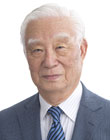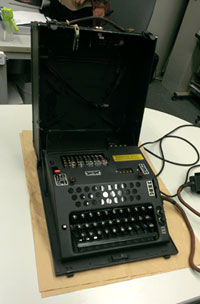Top>Opinion>The tragic genius who saved the UK by breaking the Enigma Code —The Achievements of Alan Turing (The main character in the recent film The Imitation Game)—
 Index
Index

Shigeo Tsujii【profile】
The tragic genius who saved the UK by breaking the Enigma Code
—The Achievements of Alan Turing (The main character in the recent film The Imitation Game)—
Shigeo Tsujii
Professor, Research and Development Initiative, Chuo University
Area of Specialization: Information security and theory and history of code
A bold conjecture using a historical “what if?”
The Imitation Game has recently been showing in cinemas. The main character is Alan Turing (1912 to 1954), a genius mathematician who created the mathematical model for computers around 1940 and made an outstanding contribution to the United Kingdom’s wartime victory by breaking the Enigma code of Nazi Germany.
It is often claimed that solving the Enigma code shortened the Second World War by two years, but if I were allowed to make one of the bold historical “what if?” conjectures that Michifumi Isoda (coordinator for NHK BS Television’s Eiyutachi no Sentaku [The Choices of Heroes] program) has become so well known for, it would be the following:
“If the Enigma code had not been successfully broken the United Kingdom would have lost the War and the post-Second World War order would have been one of a conflict between the United States and Nazi Germany, rather than the United States and the Soviet Union.”
The fate of military diplomacy codes and the tragedy of Turing
Why did the life of somebody who made such a stunning contribution to his country have to end in such tragedy at the age of 41? One reason was the fateful role that code was to play in war. Another was his personal orientation at a time when homosexuality was legally prohibited.
When the Second World War started, the American transport ships that carried goods and materials to the United Kingdom were being sunk by German U-boat submarines one after another, and a sense of impeding defeat was beginning to grow in the United Kingdom. Submarines used coded messages, and if the code could be solved the transport ships would be able to avoid the U-boat attacks. The man who successfully broke the code was Alan Turing.
However, if the enemy discovered that its code had been broken it would change the structure of its code machines and it would take many more months to solve the new code. Unlike Japan’s leaders, Britain’s prime minister at the time Winston Churchill was well aware of the value of information and was passionate about its collection, analysis and use. At one point, the decoding of Enigma provided intelligence that the Luftwaffe was to attack the historical city of Coventry in the United Kingdom. However, to avoid suspicion that the code had been broken, Churchill ruthlessly allowed Coventry to be bombed by the enemy. He sacrificed its historical cathedral and several hundred lives in order to defeat Germany. With code destined to be used in this way, Alan Turing’s achievements were to remain a state secret for many years. Tragically, he is said to have committed suicide using potassium cyanide because of his homosexual orientation (which was subject to criminal sanctions at the time).
Numerous television appearance by the Tsujii Laboratory’s Enigma machine

The Enigma code machine held by the Tsujii Laboratory
There are said to be only two Enigma code machines in Japan, including one replica. I keep one of these (the replica) at a laboratory at the Chuo University Research and Development Initiative. In connection with the screening of The Imitation Game, this enigma machine starred on Fuji TV’s Mezamashi TV program on Sunday March 8, 2015. (I also made an appearance on the program as a supporting actor!) The machine also appeared on Nippon Television’s SUKKIRI!! show on Monday, March 16, during a section introducing the film. My beloved machine also appeared in a program hosted by Akira Ikegami around two years ago, although this program was not related to The Imitation Game.
During preparations for the Akira Ikegami program, I made a request that we recognize the importance of code in terms of military and diplomatic history but also that we show how public-key cryptography provides a platform for society and everyday life in the modern age. However, I was told that they would not be able to do this. Public-key cryptography is a revolutionary type of code through which one half of a key is made public. (One book on the history of science even claimed that the invention of public-key cryptography was comparable to the invention of gunpowder!) Public-key cryptography plays a role in maintaining the confidentiality of information. However, it plays an even more significant role as the key technology of digital society through authentication (“I am who I say I am”) and signature (“this document was written by me”).
Public-key cryptography also invented by the British intelligence— delivering the key safely
It was previously thought that public-key cryptography was a post-war American invention of the late 1970s prior to the arrival of the information society. However, the truth is that it was invented several years earlier by the British intelligence service. It was intended for use in maintaining military and diplomatic confidentiality, rather than authentication and signatures. In most cases, codes are broken because the key can be guessed. The basis for public-key cryptography is the fact that the key is distributed confidentially.
In the Pacific War, a major factor in the decisive defeat suffered by the Imperial Japanese Navy at the Battle of Midway was the fact that Japan’s code had been decoded by the Americans. How was the code broken? One significant reason was the fact that Japan had not been able to exchange keys in time.
As an aside, you may be interested to know that Kazutoshi Hando made the following impassioned claim on television: “People often say that the reason Midway was lost was because Japan’s code was broken, but that’s not true. It was arrogance.” It is true that for around six months after the success of the surprise attacks on Pearl Harbor the Japanese military became used to winning every battle they fought and became extremely arrogant. However, it is also a fact that United States Admiral Nimitz claimed that America would have been completely defeated had it not been for its success in breaking the code. What’s more, people only talk about the fact that Japan’s code was broken but I would like to add the fact that Japan broke many of America’s codes, to honor the record of Japan’s codebreakers in those times.
Safely carrying a key thus can be as important as victory or defeat. For this reason, the researchers at the British intelligence service wondered if there was a way of carrying the key with complete confidence in “broad daylight.” They came up with a method of making the encryption key public while maintaining the secrecy of the key used to convert the coded message into plain text. This was in the early 1970s, several years before America’s invention of public-key cryptography. However, it was only around 20 years after this invention that this fact became public knowledge. An achievement that undoubtedly would have been recognized with a Nobel Prize if one was awarded in the field of information ended up being covered up as a national secret.
The Turing Award—the “Nobel Prize for Information Science”
In an environment that prioritized the confidentiality of code, Turing’s life was to end in tragedy. The fate of a codebreaker was once seen as something akin to an actor dying a lonely death in a historical drama, but half a century after his death, Turing’s name has been restored. In 2009, British Prime Minister Gordon Brown issued a posthumous apology to Turing from the British government, and in 2013 Turing was granted a Royal pardon by Her Majesty Queen Elizabeth II.
The Turing Award was established in the field of information at an early stage in recognition of Turing’s role as the founder of information science, rather than as a code-breaker, but newspapers and other media appear only to be interested in the Nobel Prize and have failed to give the Turing Award significant coverage. This is extremely sad.
From dark code to bright code-managing the “key” still the crucial factor
As described above, code has traditionally had something of a “dark” image. However, as a general rule, modern code uses public-key encryption and in the 1990s our group of researchers held a series of research seminars entitled “Akarui Ango Kenkyukai [Bright Code Seminars].” When research on modern code began, people became interested in the possibility of its usefulness for the information society, and not just for military and diplomacy. When I presented Seiko Noda (Minister of Posts and Telecommunications at the time) with a copy of my book Code—The Technology and History of Information Security [Ango—Jyoho Sekyuritei no Gijyutsu to Rekishi] (Kodansha Gakujutsu Bunko), she told me “I’ve wanted to read a book like this for a long time!” I was then called to give a speech to the director-generals of the (former) Ministry of Finance bureaus and was asked questions that would have stretched even an expert!
However, the more that modern code becomes a key part of our social infrastructure, the more it becomes an unsung hero (often the fate of new technologies), and the more that interest from society wanes. What’s worse, the management of keys has been neglected and there have been some notorious cases of codes being broken. Modern code prioritizes mathematical authentication, and commercially available code is rarely decoded at a theoretical level. However, there have been numerous cases of slack production and management of keys. It doesn’t matter how strong your safe is if you leave the key lying on top of the safe. The importance of looking after the key has not changed from the classical code of Turing’s time through to the modern codes that support people’s daily lives today.
- Shigeo Tsujii
Professor, Research and Development Initiative, Chuo University
Area of Specialization: Information security and theory and history of code - Shigeo Tsujii was born in 1933 (81 years old).
Current positions:
Professor, Research and Development Initiatives, Chuo University
Director of the Foundation for MultiMedia Communications
Director of Secure Broadcasting Authorization and Research Center
Professor Emeritus, Tokyo Institute of Technology
Professor Emeritus (and first President), Institute of Information Security
Profile
1958: BE in Electrical Engineering, Tokyo Institute of Technology
1970: Ph.D. (Engineering), Tokyo Institute of Technology
1978: Professor, School of Engineering, Tokyo Institute of Technology
1994: Professor, Faculty of Science and Engineering, Chuo University
1996: President, Institute of Electronics, Information and Communication Engineers
1999: President, Research and Development Initiatives, Chuo University
2000: Chair, Radio Regulatory Council, Ministry of Internal Affairs and Communications
2003: Member, Science Council of Japan
2004: President, Institute of Information Security
2007 to present: Member, Japan P.E.N. Club
Awards
1978: Commendation for Invention (Kanto Region)
1996: IEICE Distinguished Achievement and Contributions Award
2004: NHK Broadcasting Culture Award
2009 Order of the Sacred Treasure, Gold Rays with Neck Ribbon
2014: NEC C&C Prize
Publications
Code—The Technology and History of Information Security [Ango—Jyouho Sekyuritei no Gijyutsu to Rekishi], Kodansha Gakujutsu Bunko
Information Society, Security and Ethics [Jyoho Shakai, Security, Rinri], edited by The Institute of Electronics, Information and Communication Engineers, Corona Publishing
- Research Activities as a Member of Research Fellowship for Young Scientists (DC1), Japan Society for the Promotion of Science (JSPS) Shuma Tsurumi
- Important Factors for Innovation in Payment Services Nobuhiko Sugiura
- Beyond the Concepts of Fellow Citizens and Foreigners— To Achieve SDGs Goal 10 “Reduce Inequality Within and Among Countries” Rika Lee
- Diary of Struggles in Cambodia Fumie Fukuoka
- How Can We Measure Learning Ability?
—Analysis of a Competency Self-Assessment Questionnaire— Yu Saito / Yoko Neha - The Making of the Movie Kirakira Megane








